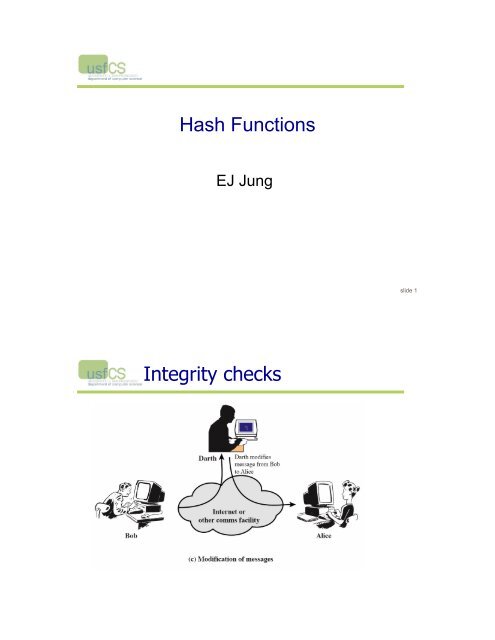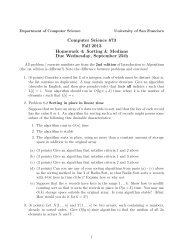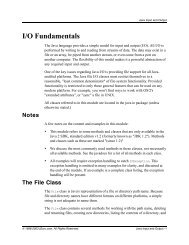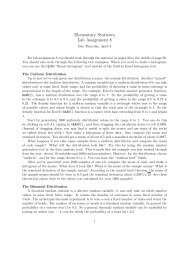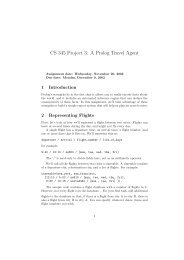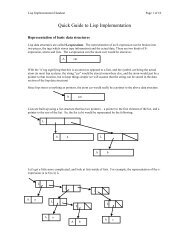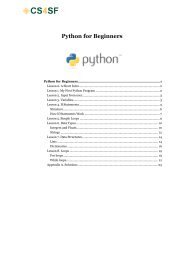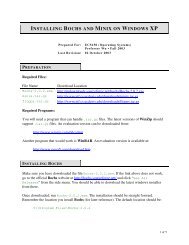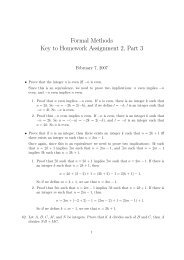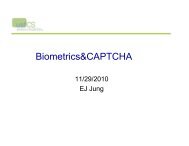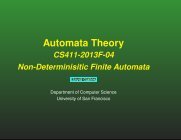Secure Hash Functions
Secure Hash Functions
Secure Hash Functions
Create successful ePaper yourself
Turn your PDF publications into a flip-book with our unique Google optimized e-Paper software.
<strong>Hash</strong> <strong>Functions</strong><br />
EJ Jung<br />
slide 1<br />
Integrity checks
Integrity vs. Confidentiality<br />
! Integrity: attacker cannot tamper with message<br />
! Encryption may not guarantee integrity!<br />
• Intuition: attacker may able to modify message under<br />
encryption without learning what it is<br />
– Given one-time key K, encrypt M as M!K… Perfect secrecy, but<br />
can easily change M under encryption to M!M’ for any M’<br />
– Online auction: halve competitor’s bid without learning its value<br />
• This is recognized by industry standards (e.g., PKCS)<br />
– “RSA encryption is intended primarily to provide<br />
confidentiality… It is not intended to provide integrity”<br />
• Many encryption schemes provide secrecy AND integrity<br />
slide 3<br />
More on Integrity<br />
VIRUS<br />
goodFile<br />
badFile<br />
BigFirm<br />
The Times<br />
hash(goodFile)<br />
User<br />
Software manufacturer wants to ensure that the executable file<br />
is received by users without modification…<br />
Sends out the file to users and publishes its hash in NY Times<br />
The goal is integrity, not confidentiality<br />
Idea: given goodFile and hash(goodFile),<br />
very hard to find badFile such that hash(goodFile)=hash(badFile)<br />
slide 4
Where to use hash functions<br />
! Cookie<br />
• H(server’s secret, client’s unique information,<br />
timestamp)<br />
! Password storage<br />
• safe against server problems<br />
<strong>Hash</strong> <strong>Functions</strong><br />
! Purpose of the HASH function is to produce<br />
a ”fingerprint”.<br />
! But, what do you mean by fingerprint<br />
Henric Johnson 6
<strong>Secure</strong> <strong>Hash</strong> <strong>Functions</strong><br />
! Properties of a HASH function H :<br />
1. H can be applied to a block of data at any size<br />
2. H produces a fixed length output<br />
3. H(x) is easy to compute for any given x.<br />
4. For any given block x, it is computationally<br />
infeasible to find x such that H(x) = h<br />
5. For any given block x, it is computationally<br />
infeasible to find y ! x with H(y) = H(x).<br />
6. It is computationally infeasible to find any pair<br />
(x, y) such that H(x) = H(y)<br />
Henric Johnson 7<br />
Simple hash function
Example<br />
<strong>Hash</strong> <strong>Functions</strong>: Main Idea<br />
x’’<br />
message<br />
x.<br />
. .<br />
x’<br />
hash function H<br />
“message<br />
digest”<br />
. .<br />
y<br />
y’<br />
bit strings of any length<br />
! H is a lossy compression function<br />
n-bit bit strings<br />
• Collisions: h(x)=h(x’) for some inputs x, x’<br />
• Result of hashing should “look random” (make this precise later)<br />
– Intuition: half of digest bits are “1”; any bit in digest is “1” half the time<br />
! Cryptographic hash function needs a few properties…<br />
slide 10
One-Way<br />
! Intuition: hash should be hard to invert<br />
• “Preimage resistance”<br />
• Let h(x’)=y"{0,1} n for a random x’<br />
• Given y, it should be hard to find any x such that<br />
h(x)=y<br />
! How hard<br />
• Brute-force: try every possible x, see if h(x)=y<br />
• SHA-1 (common hash function) has 160-bit output<br />
– Suppose have hardware that’ll do 2 30 trials a pop<br />
– Assuming 2 34 trials per second, can do 2 89 trials per year<br />
– Will take 2 71 years to invert SHA-1 on a random image<br />
slide 11<br />
“Birthday Paradox”<br />
! T people<br />
! Suppose each birthday is a random number taken<br />
from K days (K=365) – how many possibilities<br />
• K T (samples with replacement)<br />
! How many possibilities that are all different<br />
• (K) T = K(K-1)…(K-T+1) samples without replacement<br />
! Probability of no repetition<br />
• (K) T /K T # 1 - T(T-1)/2K<br />
! Probability of repetition<br />
• O(T 2 )
Collision Resistance<br />
! Should be hard to find x, x’ such that h(x)=h(x’)<br />
! Brute-force collision search is O(2 n/2 ), not O(2 n )<br />
• n = number of bits in the output of hash function<br />
• For SHA-1, this means O(2 80 ) vs. O(2 160 )<br />
! Reason: birthday paradox<br />
• Let T be the number of values x,x’,x’’… we need to look<br />
at before finding the first pair x,x’ s.t. h(x)=h(x’)<br />
• Assuming h is random, what is the probability that we<br />
find a repetition after looking at T values O(T 2 )<br />
• Total number of pairs O(2 n )<br />
• Conclusion: T # O(2 n/2 )<br />
slide 13<br />
One-Way vs. Collision<br />
Resistance<br />
! One-wayness does not imply collision resistance<br />
• Suppose g is one-way<br />
• Define h(x) as g(x’) where x’ is x except the last bit<br />
– h is one-way (to invert h, must invert g)<br />
– Collisions for h are easy to find: for any x, h(x0)=h(x1)<br />
! Collision resistance does not imply one-wayness<br />
• Suppose g is collision-resistant<br />
• Define h(x) to be 0x if x is n-bit long, 1g(x) otherwise<br />
– Collisions for h are hard to find: if y starts with 0, then there<br />
are no collisions, if y starts with 1, then must find collisions in g<br />
– h is not one way: half of all y’s (those whose first bit is 0) are<br />
easy to invert (how); random y is invertible with probab. 1/2<br />
slide 14
Weak Collision Resistance<br />
! Given randomly chosen x, hard to find x’ such<br />
that h(x)=h(x’)<br />
• Attacker must find collision for a specific x. By<br />
contrast, to break collision resistance, enough to<br />
find any collision.<br />
• Brute-force attack requires O(2 n ) time<br />
! Weak collision resistance does not imply<br />
collision resistance (why)<br />
slide 15<br />
Which Property Do We Need<br />
! UNIX passwords stored as hash(password)<br />
• One-wayness: hard to recover password<br />
! Integrity of software distribution<br />
• Weak collision resistance<br />
• But software images are not really random… maybe<br />
need full collision resistance<br />
! Auction bidding<br />
• Alice wants to bid B, sends H(B), later reveals B<br />
• One-wayness: rival bidders should not recover B<br />
• Collision resistance: Alice should not be able to change<br />
her mind to bid B’ such that H(B)=H(B’)<br />
slide 16
Common <strong>Hash</strong> <strong>Functions</strong><br />
! MD5<br />
• 128-bit output<br />
• Still used very widely<br />
• Completely broken by now<br />
! RIPEMD-160<br />
• 160-bit variant of MD-5<br />
! SHA-1 (<strong>Secure</strong> <strong>Hash</strong> Algorithm)<br />
• 160-bit output<br />
• US government (NIST) standard as of 1993-95<br />
– Also the hash algorithm for Digital Signature Standard (DSS)<br />
slide 17<br />
Basic Structure of SHA-1<br />
Against padding attacks<br />
Split message into 512-bit blocks<br />
160-bit buffer (5 registers)<br />
initialized with magic values<br />
Compression function<br />
• Applied to each 512-bit block<br />
and current 160-bit buffer<br />
• This is the heart of SHA-1<br />
slide 18
Block Ciphers<br />
Block of plaintext<br />
S S S S<br />
S S S S<br />
Key<br />
For hashing, there is no KEY.<br />
Use message as key and replace<br />
plaintext with a fixed string.<br />
(for example, Unix password hash is DES<br />
applied to NULL with password as the key)<br />
repeat for several rounds<br />
S S S S<br />
Block of ciphertext<br />
slide 19<br />
SHA-1 Compression Function<br />
Current message block<br />
Current buffer (five 32-bit registers A,B,C,D,E)<br />
Four rounds, 20 steps in each<br />
Let’s look at each step<br />
in more detail…<br />
Very similar to a block cipher,<br />
with message itself used<br />
as the key for each round<br />
Fifth round adds the original<br />
buffer to the result of 4 rounds<br />
Buffer contains final hash value<br />
slide 20
One Step of SHA-1 (80 steps total)<br />
A<br />
B C D<br />
E<br />
5 bitwise<br />
left-rotate<br />
Logic function for steps<br />
• (B$C)%(¬B$D) 0..19<br />
• B!C!D 20..39<br />
• (B$C)%(B$D)%(C$D) 40..59<br />
• B!C!D 60..79<br />
Multi-level shifting of message blocks<br />
f t<br />
+<br />
+<br />
Current message block mixed in<br />
• For steps 0..15, W 0..15 =message block<br />
• For steps 16..79,<br />
W t =W t-16 !W t-14 !W t-8 !W t-3<br />
+<br />
W t<br />
30 bitwise<br />
left-rotate<br />
Special constant added<br />
(same value in each 20-step round,<br />
4 different constants altogether)<br />
+<br />
K t<br />
A<br />
B C D<br />
E<br />
slide 21<br />
How Strong Is SHA-1<br />
! Every bit of output depends on every bit of input<br />
• Very important property for collision-resistance<br />
! Brute-force inversion requires 2 160 ops, birthday<br />
attack on collision resistance requires 2 80 ops<br />
! Some recent weaknesses (2005)<br />
• Collisions can be found in 2 63 ops<br />
slide 22
SHA-512 big picture<br />
SHA-512 zoom in
Authentication<br />
! Authenticity is identification and assurance of<br />
origin of information<br />
• We’ll see many specific examples in different scenarios<br />
network<br />
slide 25<br />
Authentication with Shared<br />
Secrets<br />
SECRET<br />
SECRET<br />
msg, H(SECRET,msg)<br />
Alice<br />
Bob<br />
Alice wants to ensure that nobody modifies message in transit<br />
(both integrity and authentication)<br />
Idea: given msg,<br />
very hard to compute H(SECRET, msg) without SECRET;<br />
easy with SECRET<br />
slide 26
Authentication Without<br />
Encryption<br />
KEY<br />
MAC<br />
(message authentication code)<br />
KEY<br />
message, MAC(KEY,message)<br />
Alice<br />
message<br />
= <br />
Bob<br />
Recomputes MAC and verifies whether it is<br />
equal to the MAC attached to the message<br />
Integrity and authentication: only someone who knows KEY can<br />
compute MAC for a given message<br />
slide 27<br />
HMAC<br />
! Construct MAC by applying a cryptographic hash<br />
function to message and key<br />
• Could also use encryption instead of hashing, but…<br />
• <strong>Hash</strong>ing is faster than encryption in software<br />
• Library code for hash functions widely available<br />
• Can easily replace one hash function with another<br />
• There used to be US export restrictions on encryption<br />
! Invented by Bellare, Canetti, and Krawczyk (1996)<br />
! Mandatory for IP security, also used in SSL/TLS<br />
slide 28
Structure of HMAC<br />
magic value (flips half of key bits)<br />
Secret key padded<br />
to block size<br />
Block size of embedded hash function<br />
another magic value<br />
(flips different key bits)<br />
Embedded hash function<br />
(strength of HMAC relies on<br />
strength of this hash function)<br />
“Amplify” key material<br />
(get two keys out of one)<br />
“Black box”: can use this HMAC<br />
construction with any hash function<br />
(why is this important)<br />
Very common problem:<br />
given a small secret, how to<br />
derive a lot of new keys<br />
hash(key,hash(key,message))<br />
slide 29


